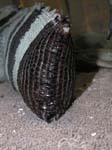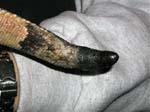

IMPORTANT: These pages on health are meant to be general guides, not hard and fast rules. They were not written by vets and are NO SUBSTITUTE for veterinary care. If you suspect something is wrong with your iguana, PLEASE see a qualified veterinarian!
Tail Loss
One of the scariest non-lifethreatening injuries that can occur for ig owners is tail loss. Iguanas are able to drop a portion of their tail as a defense mechanism against predators. When this happens to a new iguana owner, it can be a very scary experience to have their iguana running one way while they are left holding a twitching tail! The best way to avoid this is to remember never to grab for your iguana's tail. It's a good idea to also keep an eye on your feet when walking around a free roaming ig. Tail loss can also occur if the ig gets its tail stuck in a door or otherwise wedged, or from attacks by other pets such as cats and dogs.
With most tail loss injuries, the ig will recover fairly quickly if proper care is given. Injuries of any kind are stressful to iguanas, so it is important to keep your iguana as stress free as possible during this time. If the break is a clean one, there should be little to no bleeding. If there is light bleeding, then a little cornstarch can be used to stop the blood flow and help clotting. If there is substantial or continual blood loss, or if the tail did not break cleanly off or there is skin and muscle trailing from the break, then an IMMEDIATE vet trip is necessary. In the case of any tail break, it is a good idea to call your vet and see if they want you to bring them in right away, or treat them at home for a day or two until they are a little less stressed. Please let your vet make that decision!
If you are able to treat at home, soak your ig in a warm bath with some dilute betadine or nolvasan to help clean and disinfect the wound. After soaking, use some neosporin on the wound, and make sure your iguana's cage is SPOTLESS before putting them back in under their heat lamps and UVB to recover. It is very important during this time that the iguana's cage be kept extremely clean to prevent infection. Most tail wounds are left open to heal, and not stitched closed. Keep everything as clean as you can. Also keep your iguana's area calm and quiet. You and your iguana both will need some time to recover from the experience!
Most lost tails will eventually begin to grow back, as long as they were broken off in the lower portions of the tail. The new tail is usually dark gray or black in color, and rarely grows as long as the original tail.
Amputated
Tail |
Tail
Regrowth |
| Click
on thumbnail for larger picture. |
|
Search |

